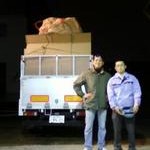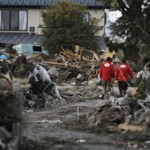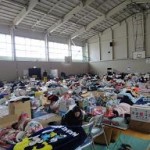JEN has been posting weekly lists of items that are needed in the region, and on the 26th they announced that a truck full of supplies had successfully headed off to deliver the collected supplies. Items on their request list for the coming week include canned foods (especially proteins like fish and meat) and food in pouches that can be easily boiled and served, sanitary products, brooms, tall boots for adults who are cleaning up the debris from the tsunami, etc.
The AAR Japan delivered fruit, other food, and fuel (kerosene, gasoline, etc.) to three locations in Miyagi Prefecture. They also surveyed the damage and needs at 12 facilities for the elderly and those with disabilities. When facilities can’t be reached by phone, the staff try to reach them in person. On the 26th, staff searched for a senior daycare center in Yamamoto (Miyagi Prefecture). Roads in that area are still not clear, so the staff searched by foot. When they came to what should have been the center, all that was left was a sign. Local police could not shed any light on what had happened. They finally reached a representative who informed them that 3 of the center’s 23 staff were confirmed dead and they had no news of the safety of the seniors who used the center. Such sad news, while disheartening, strengthens the staff’s desire to continue their efforts to help those in the region.
AMDA reports that they are continuing to provide medical care at Otsuchi (Iwate Prefecture), where the medical infrastructure of the town was devastated and the town remains relatively isolated. The majority of the patients at the Otsuchi High School evacuation site are suffering from chronic diseases, and so the presence of a pharmacist has been essential. An AMDA doctor also went with a local volunteer to deliver mobile clinic services to a more remote area where aid efforts have not reached. They visited roughly 50 households, most with elderly residents, and saw patients whose diabetes, high blood sugar, and other diseases have been untreated to date.
In Minamisanriku (Miyagi Prefecture), AMDA’s recent survey showed that many people are unable to get to the evacuation centers to receive needed medicine; symptoms of depression are on the rise among evacuees; and suspected influenza cases are also appearing. At one shelter that remains without gas, water, or electricity, evacuees were only able to take a shower for the first time on the 24th (40 people at a time for 30 minute intervals).




